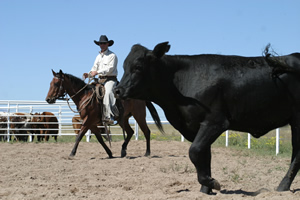Written by Martin Black
This article originally appeared in Eclectic Horseman Issue No.15
 When a horse learns some basic principles, he doesn’t need to be limited to only one discipline of cow work. Like a person learning different games with a ball, the horse can learn to play different games with a cow.
When a horse learns some basic principles, he doesn’t need to be limited to only one discipline of cow work. Like a person learning different games with a ball, the horse can learn to play different games with a cow.
Like an all-around cow horse, a good, intelligent athletic person can be a star football, basketball, or baseball player, or star in many other ball games. It takes but very little experience for the horse to recognize the environment and to differentiate the ball court or playing field, and know that there are different rules and objectives. Like the prepared athlete, the horse will know to be offensive and defensive, fast and aggressive, or soft and smooth, maintaining a lot of feel with the flow of the play.
The action of the cow, or the ball carrier, will determine the reaction of the horse, or the opposing player, and to a great extent the position of the opponent determines the action of the ball carrier, or cow. The player can affect the outcome by anticipating the play and taking a position to direct the play in a favorable way. It’s all about reading, outguessing, and responding to the cow, or the ball carrier.
I believe, given the opportunity, a horse can learn to read and anticipate the cow at least as good as a good stockman and better than a big percentage of today’s riders. The horse and cow speak the same language: as babies they race, they play aggressively or defensively, and then as they mature, for hormonal or nutritional reasons, they are constantly positioning themselves to dominate or submit to others.
Through experience comes judgment. The more and better experience the horse gets, the better his judgment will become. Being limited to one game, or one way of playing, will only limit the development of the judgment.
If a horse has some confidence or aggression and lowers his head to look the cow level in the eye, the cow will know from experience when another cow positions itself with that demeanor it is being challenged. With the horse having the large stature, the cow would likely submit to the horse.
If a young horse can first learn to dominate and control a cow, and just maintain this interest in the early stages without overwhelming him with restrictions and rules, like “position,” the cow work can be fun for him. Like the ball player keeping track of the ball, the horse needs to be able to keep track of the cow and not be distracted by a trainer’s pulling and spurring that doesn’t relate to the cow. Effort to rate the cow shouldn’t be hindered; if corrections for positions are needed, they can be in a subtle way that doesn’t discourage the horse’s interest in the cow. Like a young kid, let the fascination of the ball moving and their ability to control it create and maintain the interest. A horse that is truly interested in cattle will make a better cow horse down the road.
This article originally appeared in Eclectic Horseman Issue No.15


